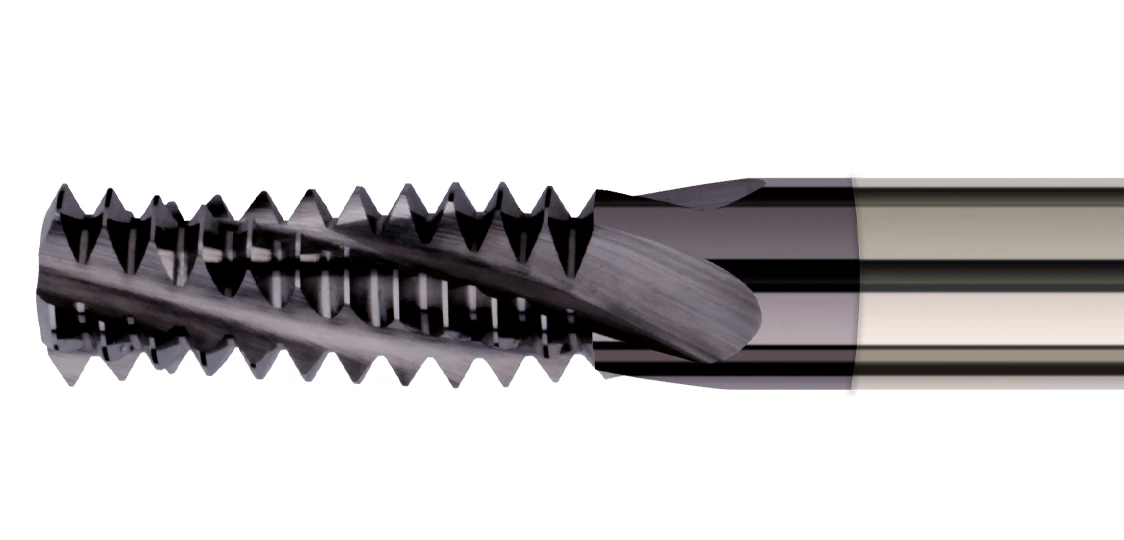Definition:
Thread milling is a cutting tool operation performed using a three-axis (or higher) machining center to mill threads. IIt is a machining process used to create threads in materials, especially in metalworking applications. Unlike traditional tapping, where a single-point tool creates the thread by cutting into the material, thread milling uses a multi-point cutting tool known as a thread mill. The thread mill moves in a helical path, gradually cutting the desired thread profile. This method offers greater flexibility in thread design, allowing for customization of thread size, pitch, and helix angles. It is particularly advantageous for producing threads in a wide size range and handling complex geometries, making it a popular choice in various industries for creating precision threads with high accuracy.The following conditions apply for the use of thread milling tools:
Threads with a length not exceeding three times the tool diameter.
Traditional methods for thread machining mainly involve using threading tools to turn threads or manually tapping threads using taps and dies. With the development of CNC machining technology, especially the emergence of three-axis CNC machining systems, a more advanced method of thread machining called thread milling has been realized. Compared to traditional thread machining methods, thread milling offers significant advantages in terms of machining accuracy and efficiency. It is not limited by thread structure or thread helix direction, as a single thread milling cutter can be used to machine various internal and external threads with different helix directions. For threads that do not allow for transitional cuts or relief grooves, it is difficult to machine using traditional turning methods or taps and dies, but it can be easily achieved through CNC milling. Additionally, the durability of thread milling cutters is several times or even dozens of times that of taps, and adjusting the thread diameter during CNC milling is much more convenient compared to taps and dies. Due to the numerous advantages of thread milling, developed countries have widely adopted milling processes for mass thread production.
The increasing application of thread milling in mechanical manufacturing has contributed to the industry’s development. When utilizing thread milling, attention should be given to suitable workpiece shapes, favorable machining strategies, and reliable thread milling cutters. Only through the comprehensive application of thread milling technology can the advantages of thread milling be fully utilized and effective results achieved. Simultaneously, it allows the performance of machine tools to be fully demonstrated, further driving the production capacity of thread milling cutters.
Advantages:
- Lower cost: Although individual thread milling cutters are more expensive than taps, when considering the cost per threaded hole, thread milling is more cost-effective.
Despite the higher initial investment in specialized thread milling tools, the longer tool life, versatility in handling different thread sizes, and elimination of custom tooling expenses result in reduced long-term costs. Additionally, thread milling’s ability to perform multiple operations in one pass improves machining efficiency, further contributing to cost savings. Industries seeking cost-effective and efficient threading solutions, especially for precision threads with diverse specifications, can benefit greatly from utilizing thread milling.
- Higher precision: Thread milling cutters achieve precision through tool compensation, allowing customers to choose the desired thread accuracy.
Better surface finish: Threads milled by thread milling cutters have a more attractive appearance compared to those produced by taps.
- Longer tool life: The tool life of thread milling cutters is several times or even dozens of times that of taps, reducing tool change and setup time.Thread milling employs a multi-point cutting tool, known as a thread mill, which distributes cutting forces across multiple teeth. This design reduces the wear on individual cutting edges, leading to decreased tool deterioration and extended tool life. As a result, manufacturers can carry out more threading operations before needing to replace the thread milling tool. This enhanced tool durability not only reduces tooling costs but also minimizes machine downtime for tool changes, ultimately improving overall productivity and efficiency in the machining process.
- Resilience against breakage: If a thread milling cutter breaks, it can be easily extracted without causing workpiece scrap, unlike taps which may lead to workpiece rejection.
- Higher machining efficiency: Thread milling cutters have a significantly higher machining efficiency compared to taps. The unique design of thread milling tools allows for simultaneous cutting along multiple points of the thread, resulting in a continuous and smooth machining process. This eliminates the need for pecking or retracting movements that are common in tapping, reducing machining time and improving overall efficiency. Additionally, thread milling can handle multiple threading operations in a single pass, further increasing productivity and reducing production cycle times.
- Blind hole capabilities: Thread milling cutters can mill threads all the way to the bottom of blind holes, which taps cannot achieve.
- One-tool versatility: For certain materials, thread milling cutters can drill, mill threads, and chamfer all in one operation, while taps cannot.
- Machining of different thread directions: A single thread milling cutter can machine both internal and external threads with different helix directions, whereas taps cannot.The one-tool versatility of thread milling enhances overall productivity by minimizing setup time and tool changeovers, resulting in smoother and more efficient production processes. Industries with varying threading requirements can benefit significantly from the time and cost savings, as well as the increased precision and consistency offered by thread milling’s one-tool versatility. It provides manufacturers with a reliable and convenient solution to meet a wide array of threading needs, making it a preferred choice for many applications in the metalworking industry.
- Common use for the same pitch: For threaded holes with the same pitch but different sizes, taps require multiple replacements, whereas thread milling cutters can be used universally.In traditional tapping methods, each thread size typically requires a dedicated tap with a specific pitch, resulting in a considerable inventory of different taps. However, with thread milling, a single thread mill can be used for multiple thread sizes as long as they share the same pitch. This streamlines inventory management and reduces the need for numerous tool variations, leading to cost savings and improved operational efficiency.
- Corrective measures for thread inspection: If the thread hole does not meet specifications initially, thread milling cutters can be adjusted through tool compensation, whereas taps do not offer this capability, leading to workpiece rejection.
- Efficient for large thread holes: Taps have lower efficiency when machining larger thread holes, whereas thread milling cutters can achieve instant results.
- Chip formation and removal: Thread milling cutters produce short, powder-like chips without chip entanglement, while taps generate spiral-shaped chips that can easily entangle the tool.
- Reduced machine load and cutting forces: Thread milling cutters have smaller machine loads and cutting forces compared to taps, as they employ non-full-tooth contact cutting.Unlike traditional tapping, which involves continuous engagement of the tap with the workpiece, thread milling spreads the cutting forces across multiple teeth of the thread mill. This distributed cutting action leads to a smoother and more stable cutting process, resulting in reduced vibration and minimized stresses on the machine and the workpiece.
- Simplified tool clamping: Taps require flexible tapping holders, while thread milling cutters can be used with ER, HSK, hydraulic, thermal expansion, and other types of tool holders.
- Interchangeable shanks: A single disposable thread milling cutter holder can accommodate metric, imperial, and other types of inserts, providing cost-effectiveness.Thread milling tools are designed with a shank separate from the cutting portion, allowing for easy replacement or interchangeability of the shank as needed. This feature offers several benefits to manufacturers and machinists.
- Machining high-hardness threads: Taps suffer severe wear and may even be unable to machine high-hardness threads, while thread milling cutters can easily accomplish the task.
Three Types
- Solid-type:
Solid-type thread milling cutters are suitable for milling small to medium-diameter threads in steel, cast iron, and non-ferrous metals. They provide stable cutting performance and high durability. Different coating options are available for machining different materials.
- Indexable-insert-type:
Indexable-insert-type thread milling cutters consist of a cutter holder and inserts. The inserts are easy to manufacture and have lower prices. Some thread inserts can be used for double-sided cutting. However, their impact resistance is slightly lower compared to solid-type thread milling cutters. Therefore, this type of tool is commonly recommended for machining aluminum alloy materials.
- Welding-type:
Welding-type thread milling cutters are used for deep holes or special workpieces. They involve welding the thread milling cutter head onto another tool, creating a DIY-style thread milling cutter. These cutters have lower strength and flexibility. The safety factor depends on the material of the workpiece and the skills of the thread milling cutter manufacturer.
Brand Introduction:
Major international tool manufacturers, known for producing general tools and measuring instruments, also produce thread milling cutters. Some of these well-known brands include Advent, Sandvik, Sandvik Coromant, Iscar, Kennametal, and others. Additionally, there are specialized manufacturers that focus on producing thread milling cutters, such as CARMEX, Vargus, and ALEX, which hold a significant market share. Domestic manufacturers in China have also been continuously imitating and making breakthroughs in production technology. However, the market is filled with a mix of brands, and for those seeking higher-quality domestically produced thread milling cutters, it is advisable to stick with established major tool manufacturers. Nonetheless, the quality still lags behind that of European and American brands.
Applications:
Mold Manufacturing: Molds are precision machinery with high production costs. Therefore, thread milling cutters are used in the production of large molds to ensure accurate pitch and well-formed thread profiles, guaranteeing the quality of the workpiece.The efficiency of thread milling contributes to reduced lead times in mold manufacturing. The ability to perform multiple threading operations in one pass and minimize cutting forces leads to faster machining and streamlined production processes. Additionally, thread milling’s one-tool versatility simplifies programming and setup, enabling manufacturers to meet tight production schedules and enhance overall efficiency.
Non-Rotational or Asymmetric Parts: For parts with asymmetrical shapes, using thread turning methods faces difficulties in clamping. Thread milling cutters can overcome these challenges and maintain machining precision.While conventional threading methods like tapping and single-point threading are limited to rotational components, thread milling provides a practical solution for creating precise threads on irregular and complex geometries. This discussion explores the applications of thread milling for non-rotational or asymmetric parts and the benefits it offers in terms of accuracy, flexibility, and expanded design possibilities.
Large Bore Diameter and Interrupted Cutting: Thread milling cutters are suitable for machining large bore diameters and handling interrupted cutting operations efficiently.In applications with large bore diameters, thread milling stands out as a preferable choice due to its adaptability. Tapping large holes can be cumbersome and prone to tap breakage or deflection. Thread milling, on the other hand, uses a multi-toothed cutting tool that distributes the cutting forces more evenly, reducing the risk of tool failure. This ensures a smoother threading process, resulting in precise threads without compromising the structural integrity of the component.


